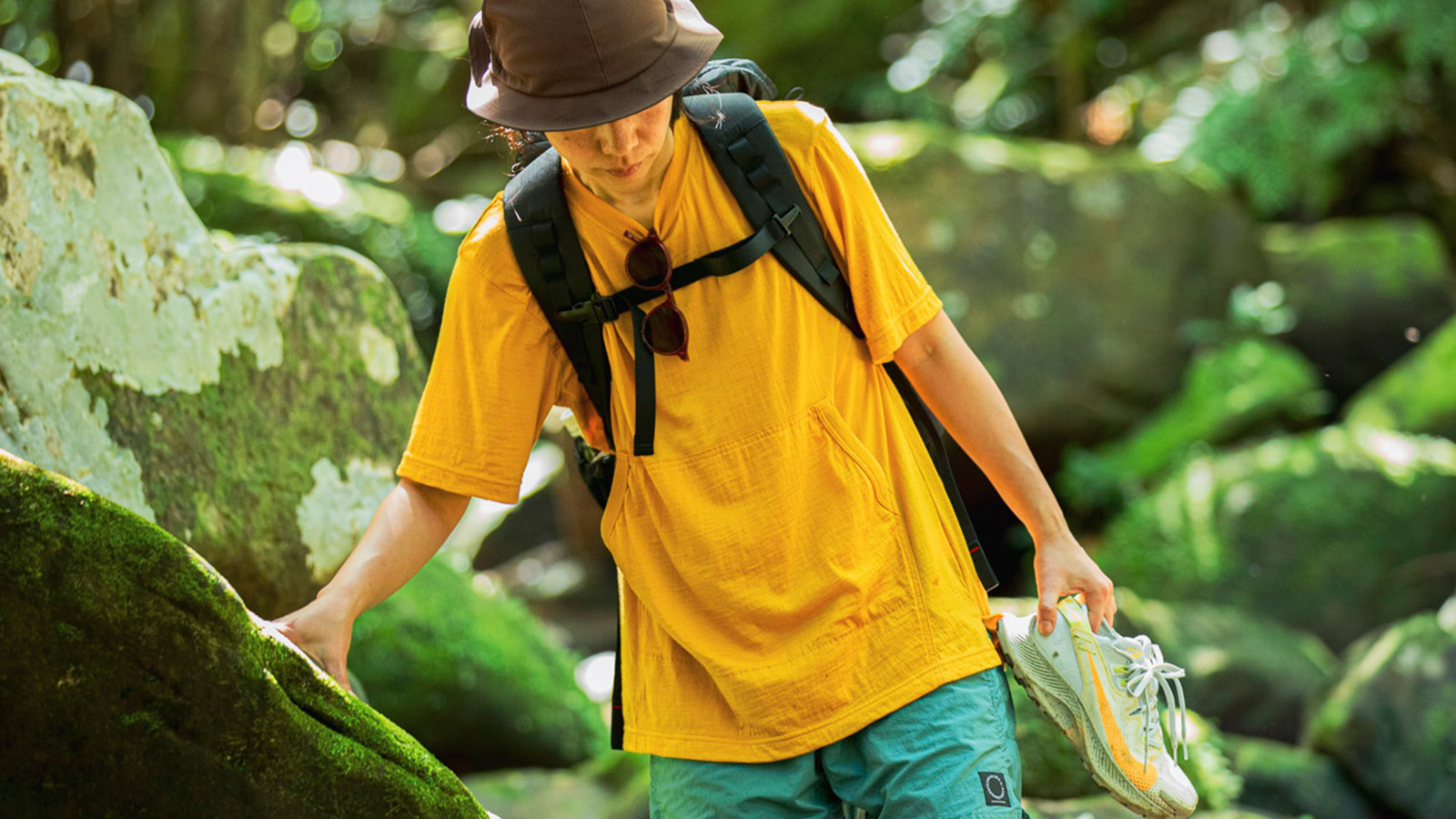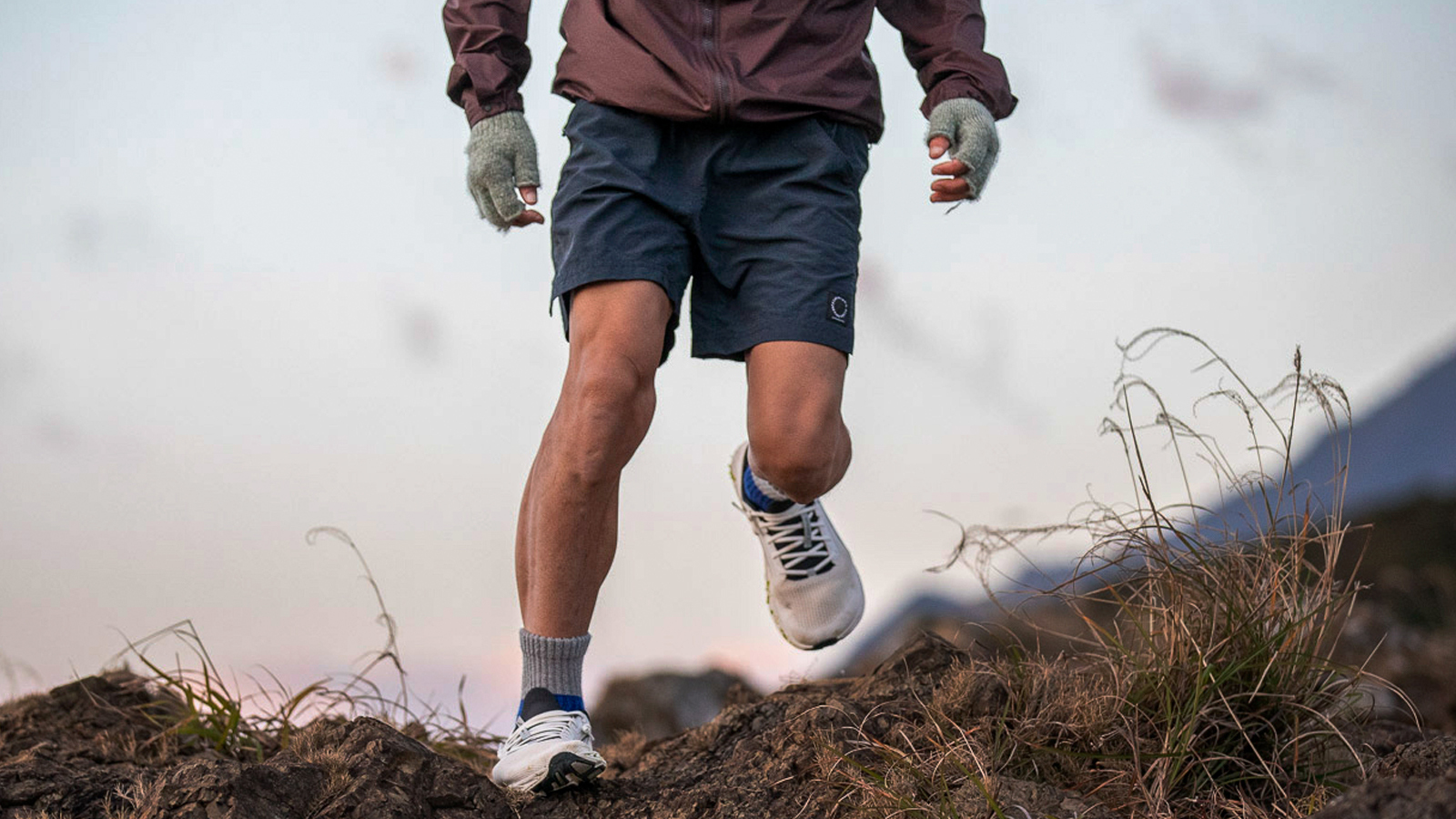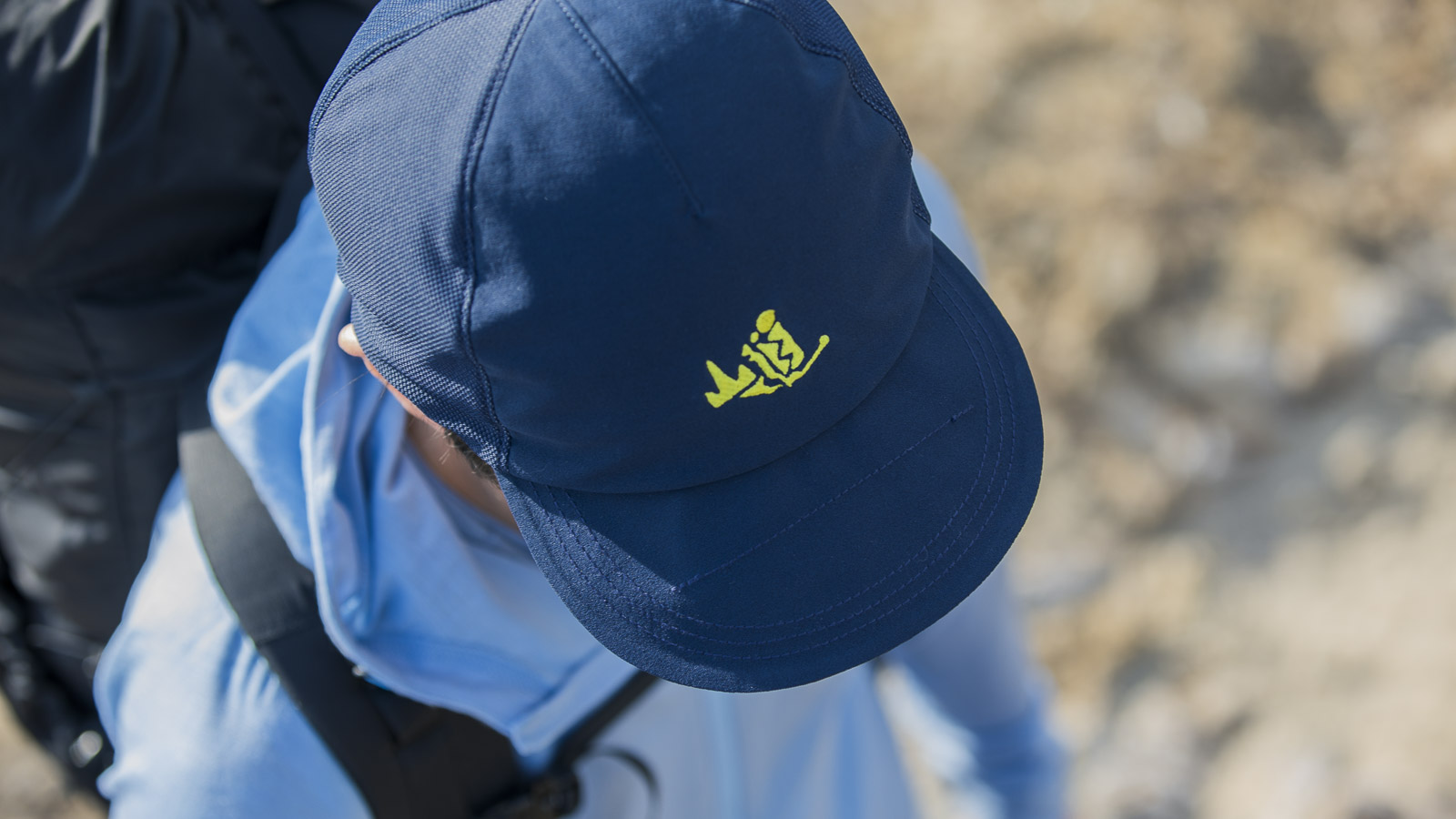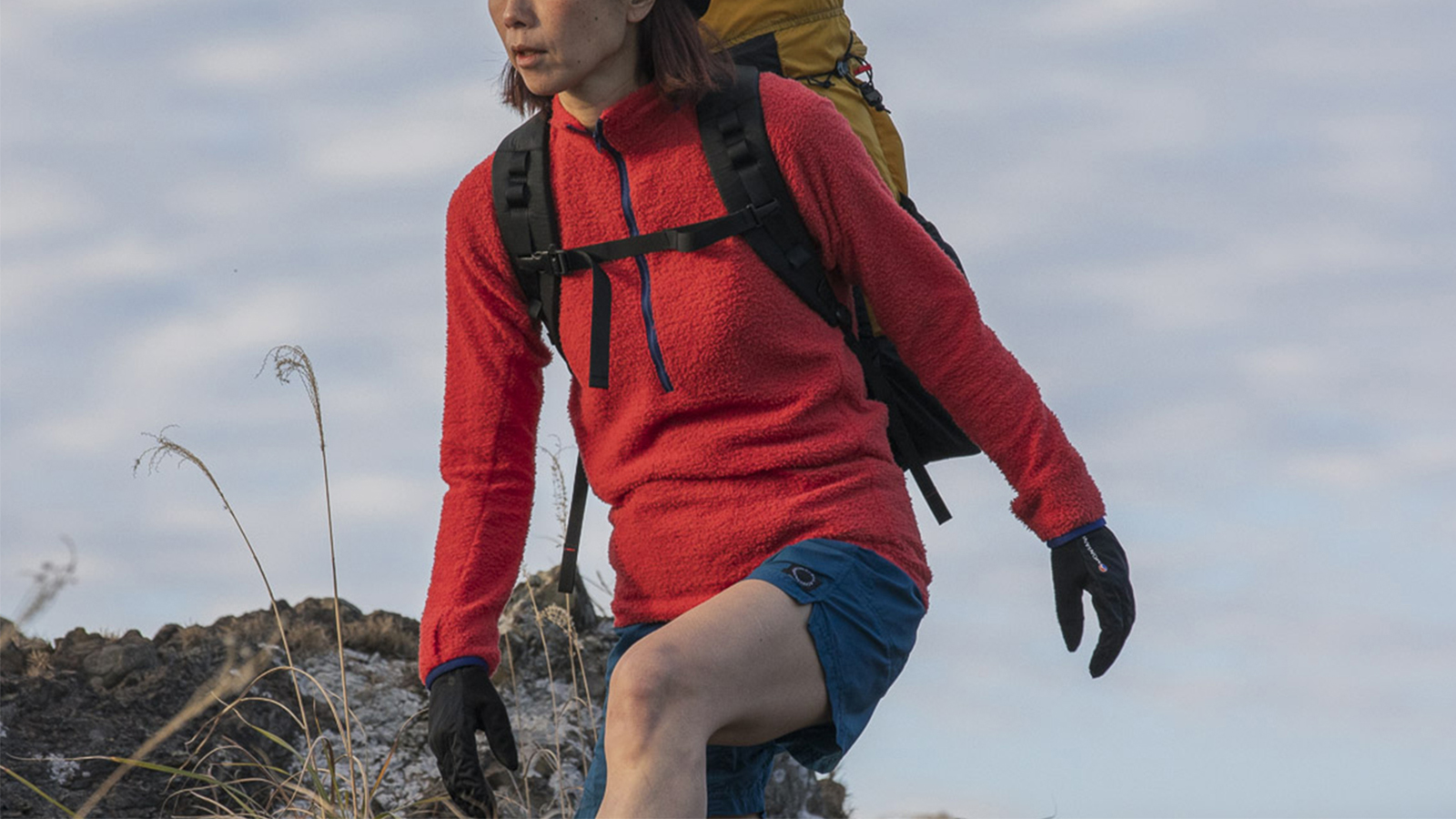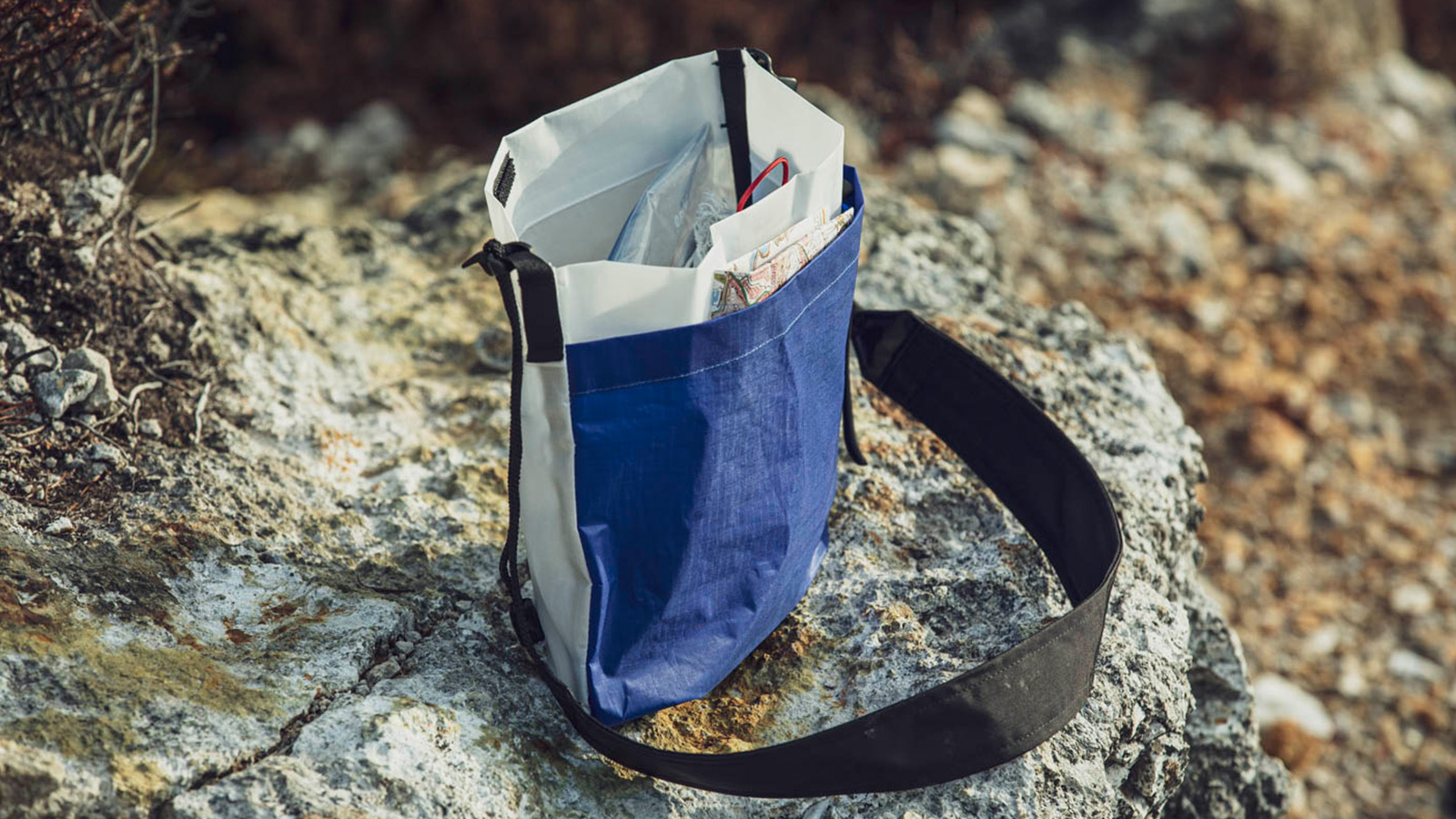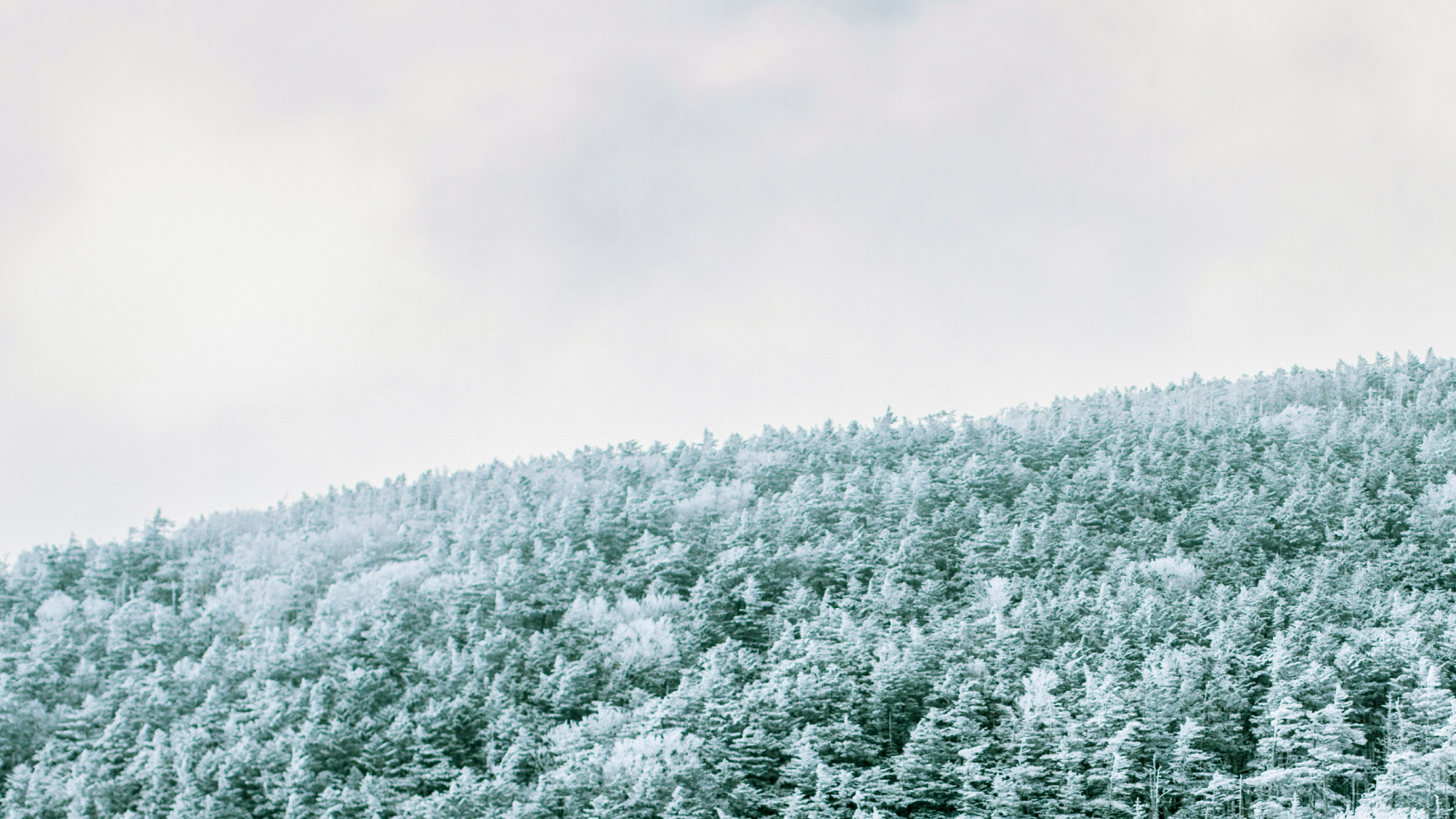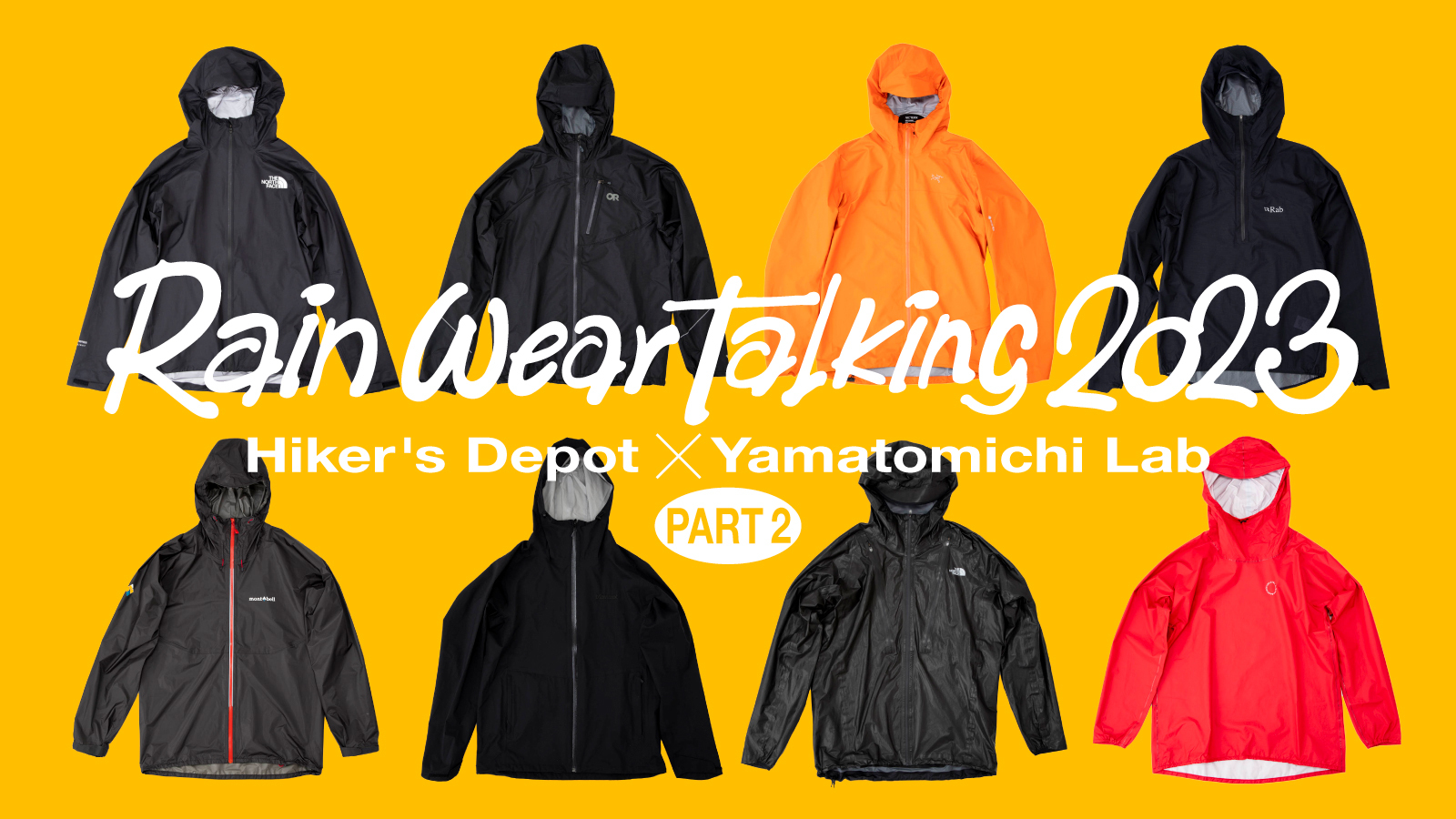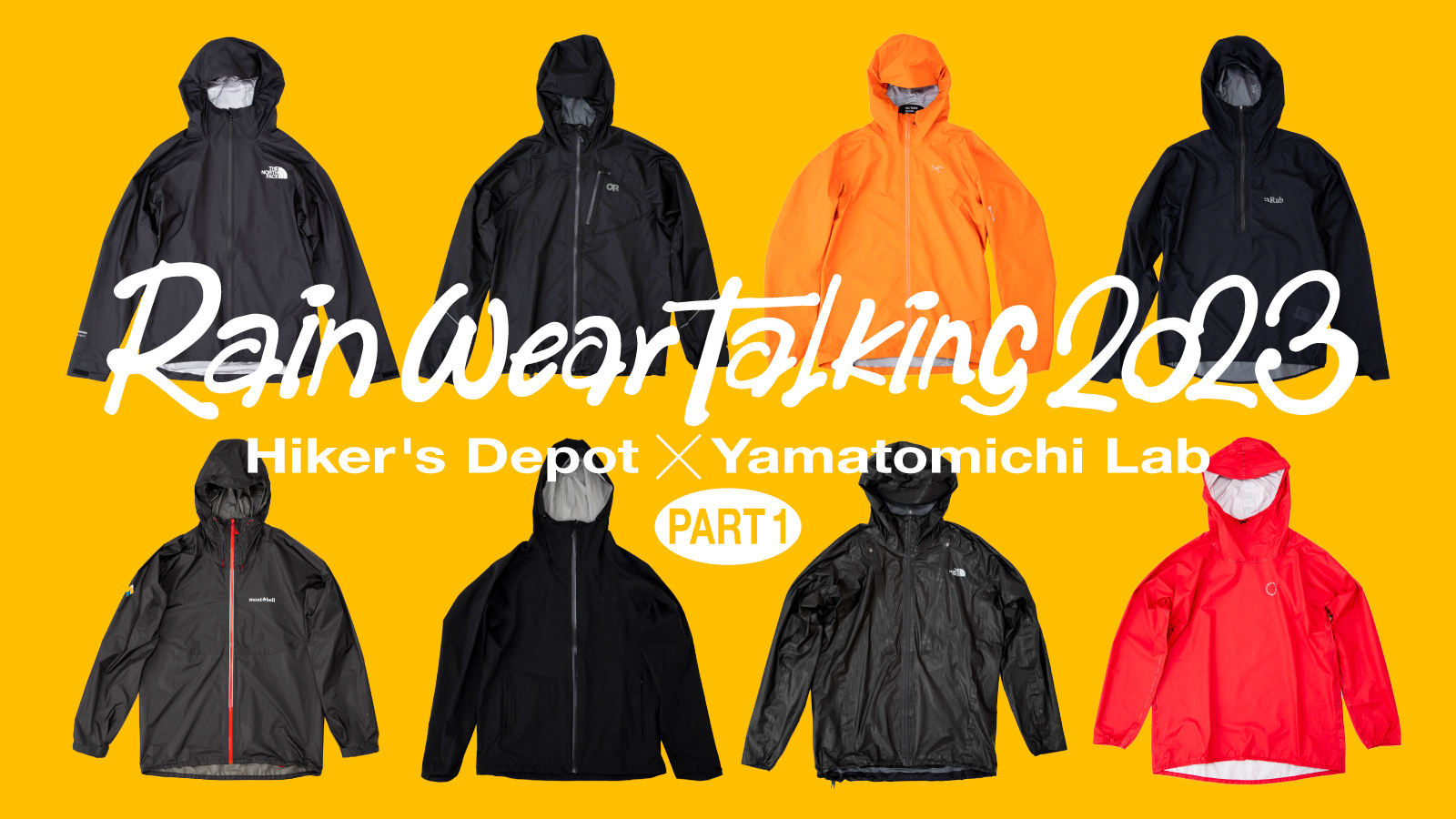Hiker’s Depot × Yamatomichi Lab – Part 2
Photos (people): Hikaru Otake
Hiker’s Depot × Yamatomichi Lab – Part 2
Photos (people): Hikaru Otake
This is part two of “Let’s Talk Rainwear Hiker’s Depot × Yamatomichi Lab”. Held at Yamatomichi Zaimokuza in Kamakura on June 18, 2023.
Continuing from part one, which unintentionally became a discussion about the development of lightweight rainwear both domestically and internationally, the second part is about the Marmot’s Zero Storm Jacket, The North Face’s HyperAir GTX Hoodie and FL Trail Peak Jacket, and our UL All-Weather Hoody. We discuss the future of rainwear, including the introduction of waterproof and breathable materials like ShakeDry, which are akin to out-of-place artifacts, and ventilated rainwear.
As usual, the content is quite specialized, but please stick with us until the end.

Photos from the event.
Continuing from part one
⑤ Marmot - Zero Storm Jacket
Rainwear with hand pockets weighing only 223g

Weight: 223g (in-house measurement of size L)
Material: Dermizax
Features: Hydrophilic non-porous membrane
Construction: 3-layer
Surface fabric: 30 denier
Water pressure resistance: 30,000mm
Breathability: 30,000g/㎡/24h
Masaaki: Next is Marmot’s “Zero Storm Jacket.” This model was introduced in 2022, but looking at the manufacturer’s website as of June 2023, it’s no longer listed, so it might be discontinued.
Akira: This product was picked by Tomoyoshi-san, but why did you choose it?
Tomoyoshi: Many lightweight rain gears don’t have pockets, right? But this one, at just over 200g, has two pockets, and it also has basic details often omitted in lightweight rainwear, like cuff and hood adjusters. Of course, no pockets make it lighter, and we often say, “We don’t need pockets because lighter is better,” but we also understand the inconvenience of not having them. So, with the overall weight reduction of rainwear, something that would have weighed 300g in the past can now be available in the low 200g range. I presented this as a sample to illustrate that. Another example is Trail Bum’s Walker Shell Jacket, which falls into the same category.

Large zippered pockets on both sides make it easy to wear as everyday clothing.
Masaaki: What kind of waterproof and breathable material is Dermizax used in this?
Takahiro: It’s a material by Toray, and under the name Dermizax, within that material there are variation like Gore-Tex and Pertex Shield type fabrics.
Masaaki: Just like how Pertex Shield has various types, non-porus or microporus materials.
Takahiro: That’s right. It’s a brand name referring to all of Toray’s waterproof and breathable materials. According to the leaflet, this jacket uses a non-porous membrane, so it’s similar to Pertex Shield.
Akira: The 30-denier surface fabric is durable, but still on the lighter side.
Masaaki: Moreover, it has horizontal stretch, making it comfortable. I tried it on, and having pockets makes it good as clothing. You might wear it casually because it’s convenient and easy to wear, not just because it’s raining. That’s the charm of rainwear that also functions as clothing.

The hood has adjusters on both cheeks.

The cuffs also have Velcro adjusters.
Tomoyoshi: Around the early 2000s when I started my shop, Integral Designs released rainwear using eVent (a waterproof and breathable membrane known for its high breathability, though its use has been declining). There were two types: the eVent Rain Jacket and the eVent Thru-Hiker Jacket. Of course, I bought the simpler and lighter Rain Jacket, which only had a small chest pocket. The Thru-Hiker, on the other hand, was long and had hand pockets. Back then, I thought the Thru-Hiker Jacket was no good because it was heavy. But upon reconsideration, I realized that during a long-distance hike lasting six months, having a longer jacket and hand pockets, even if slightly heavier, would be less stressful. My perspective shifted over the last 20 years, realizing there are things to consider other than weight and technology.
Masaaki: Although Yamatomichi’s UL All-Weather Jacket is about 100g lighter, having all the standard features of a jacket, plus stretch, at 223g is fair game for the functionality it brings to the field.
Akira: There are a lot of options to choose from these days.
Tomoyoshi: Indeed.
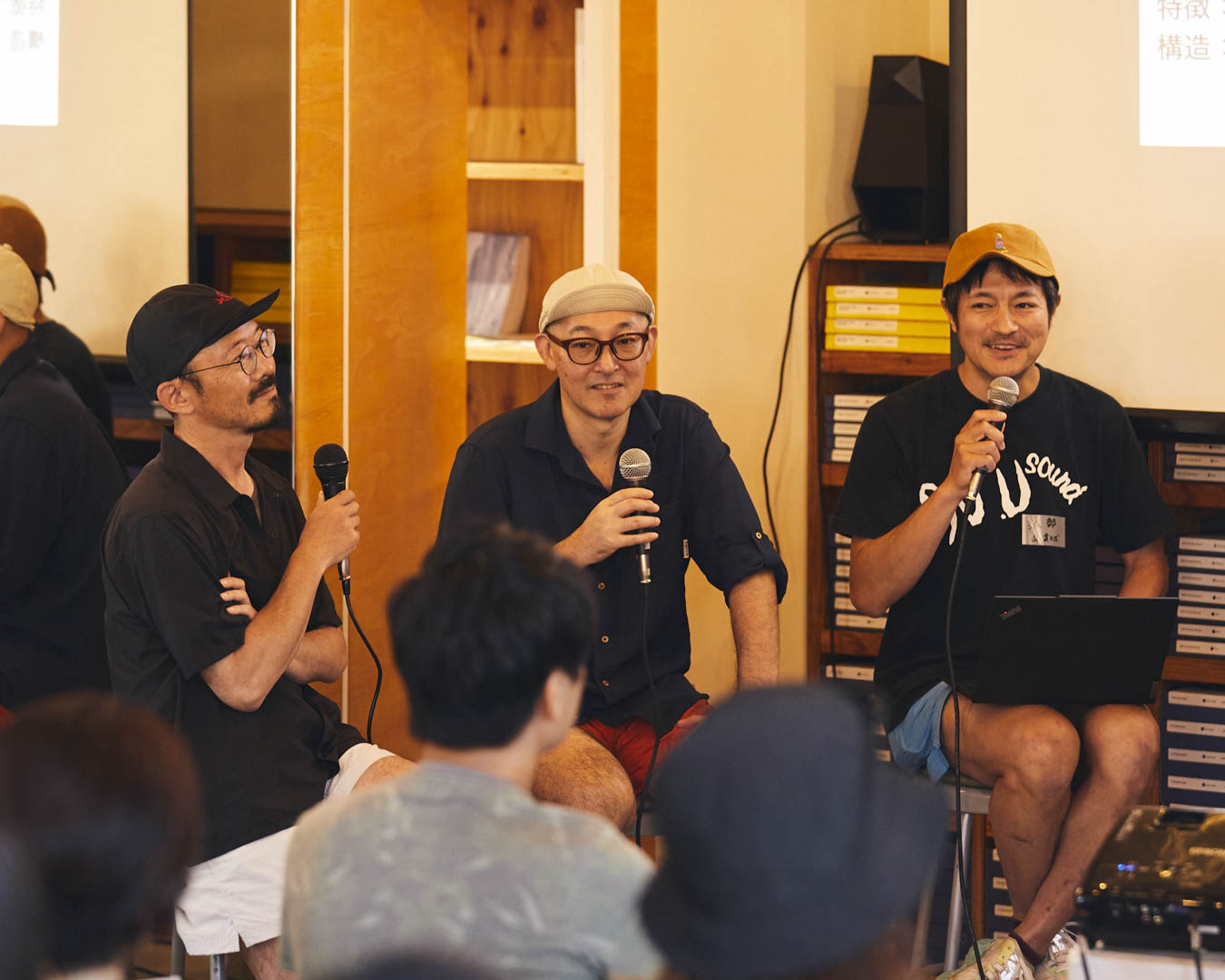
From left: Akira Natsume, Yamatomichi, Tomoyoshi Tsuchiya , Hiker’s Depot, Takahiro Watanabe , Yamatomichi
⑥ The North Face - Hyper Air GTX Hoody
A 2-layer ShakeDry Jacket that wasn't recognized in its prime.
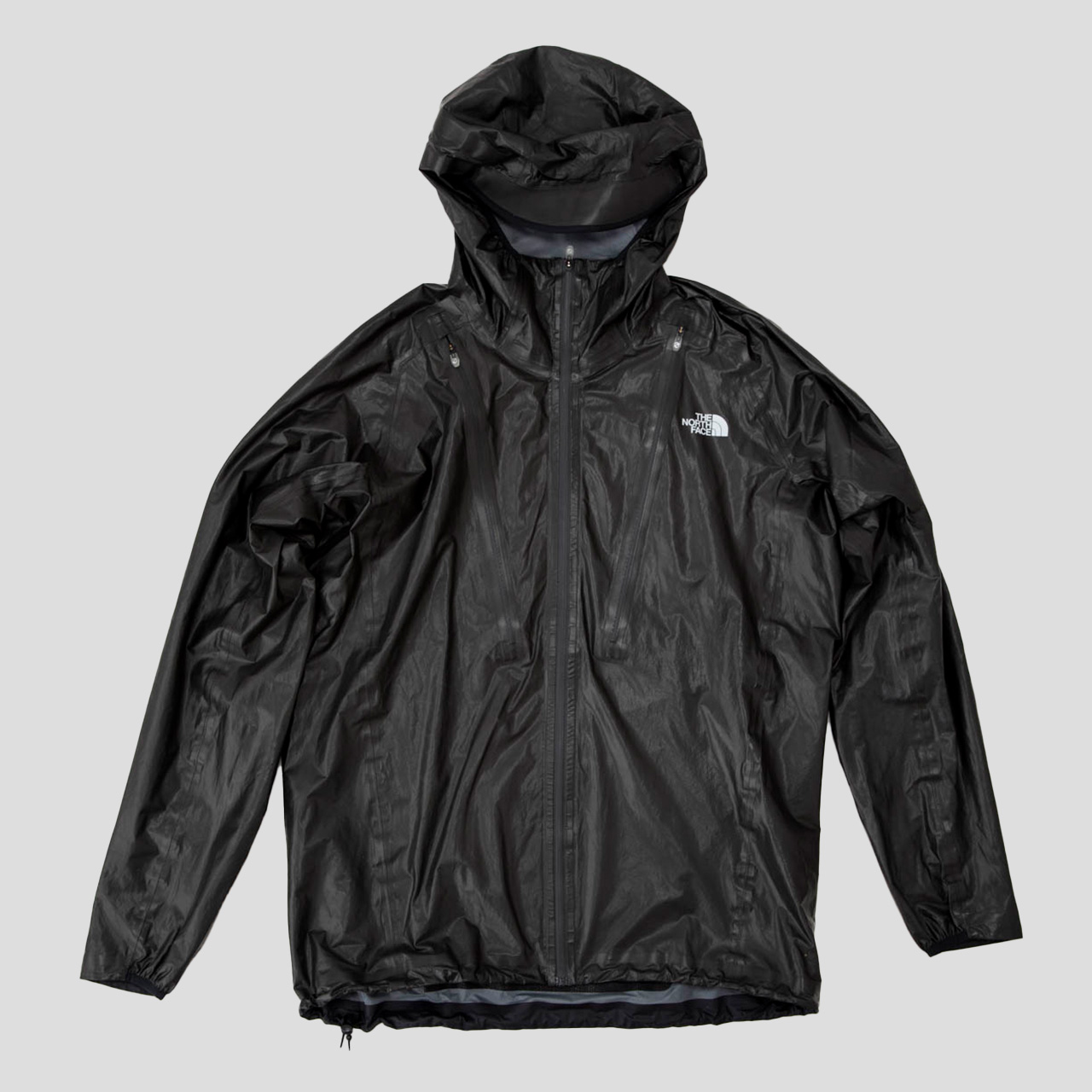
Weight: 210g
Material: Gore-Tex Active with ShakeDry
Features: Hydrophobic microporous membrane
Construction: 2-layer
Water pressure resistance: Not disclosed
Breathability: Not disclosed
Masaaki: The next product might also be discontinued, but it’s one of the most notable topics in rainwear over the past five years, using Gore-Tex Active with ShakeDry: The North Face’s “HyperAir GTX Hoodie.”
Tomoyoshi: Almost sounds like some kind of race car.
Masaaki: This one is designed specifically for trail running, with features like large zippers on the chest for vest access.

Large zippers on both chests allow access to the interior.
Akira However, due to the fluorine in Gore-Tex material becoming unusable in Europe and the U.S., ShakeDry will also be discontinued, so it won’t be available anymore in the future.
Takahiro The products currently on the market will be the last ones, so they will become like out-of-reach artifacts. If you’re interested, it might be a good idea to buy what’s available in stores now.
Masaaki Could you explain what ShakeDry is? It’s a special structure different from other waterproof and breathable materials, right?
Takahiro Yes. Normally, when you say 2-layer, it’s like the Montbell Versalite Jacket we mentioned earlier, which consists of an outer fabric and a membrane with no lining. However, in the case of the HyperAir GTX Hoody, it’s structured as a membrane that also acts as the outer fabric and a lining.
Masaaki So, in other words, there is no outer fabric, and the membrane itself is exposed on the outside.
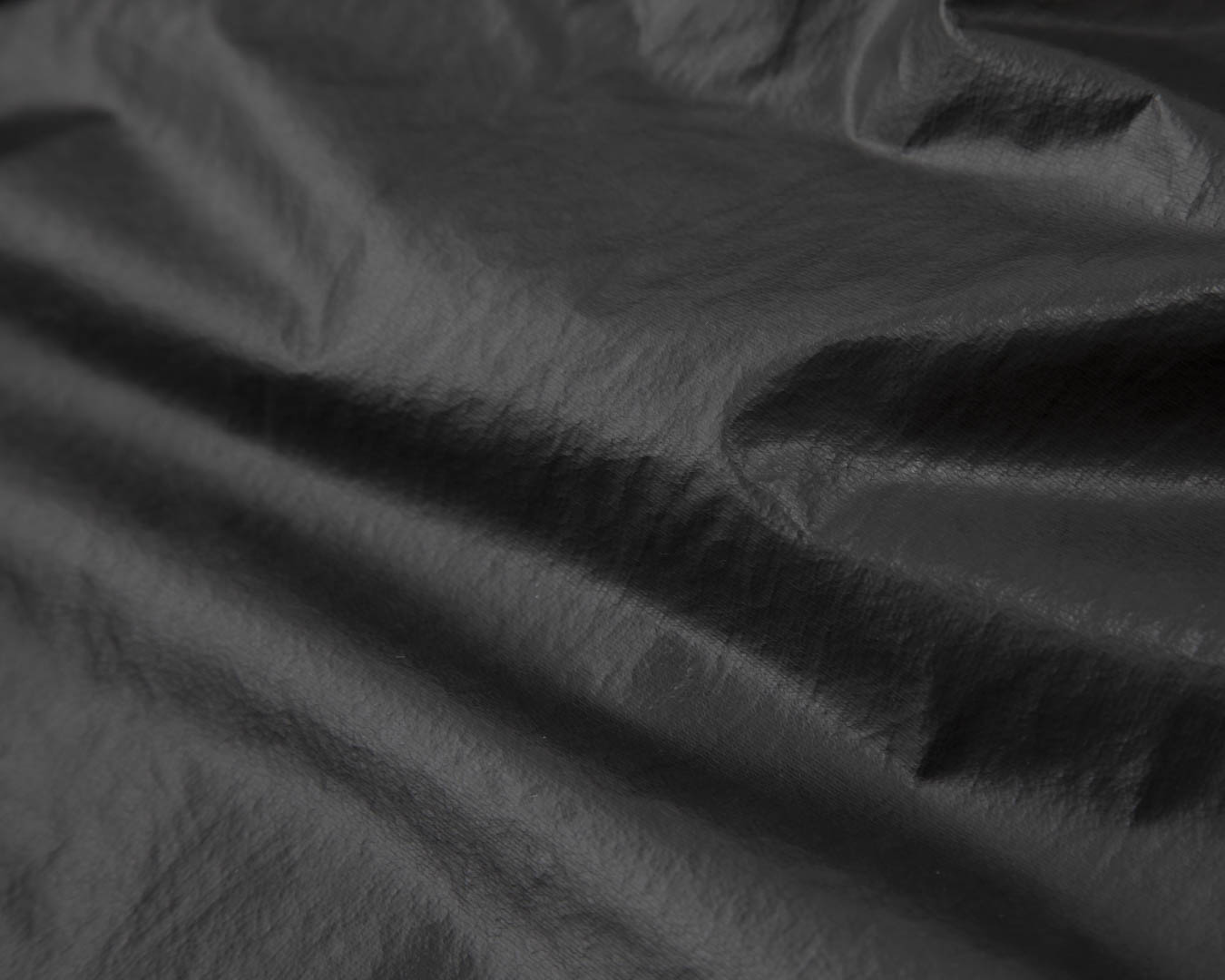
Surface fabric close-up. The membrane on the outside has a unique, slippery texture.
Takahiro: The downside of surface fabrics is that no matter how much water repellent treatment they have, they will eventually saturate and retain water. ShakeDry, however, has the membrane on the outside, and since Gore-Tex is made of fluoropolymer, it’s like a Teflon-coated frying pan, so it doesn’t retain water and repels it. Thus, its water repellency doesn’t deteriorate. The surface texture is also unique and shiny.
Masaaki: For rainwear, losing water repellency means losing functionality, so the idea of “permanently repelling water” seems like a dream material. But it didn’t become mainstream.
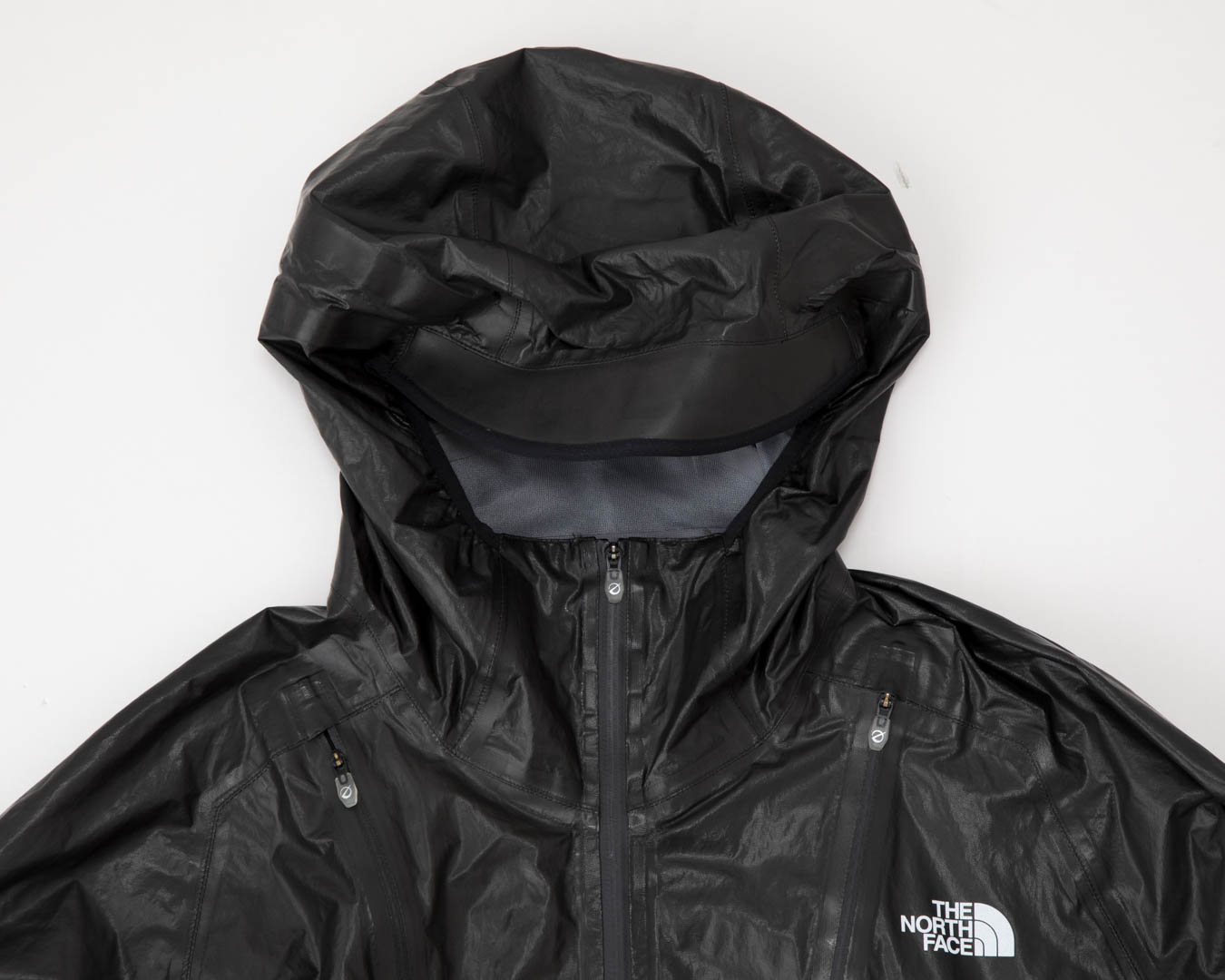
The hood has a large brim but no adjusters.
Takahiro: That’s right. The drawback is that the exposed Teflon is weak to abrasion, so it’s designed to be worn over a pack. Also, you shouldn’t expect too much; you’ll still get wet to some extent.
Akira: But among lightweight rain gear, it’s one of the more water resistant.
Takahiro: Yes, it’s more resistant and it has good breathability. However, when it’s raining, the humidity inside and outside the wear is often 100%, so even if it maintains water repellency, you’ll get wet from your own sweat. For runners, no matter how breathable the wear is, you’ll get wet from sweat. So, from a running perspective, expecting too much from rainwear might not be realistic. But as a differentiator, the sustained water repellency is a unique technology and makes it a distinctive product.

There is one pocket on the lower back.
Akira: Tomoyoshi-san, you’ve tried ShakeDry quite a bit, haven’t you?
Tomoyoshi: It’s the exact opposite of the Helium Rain Jacket, which has a more durable surface. There was concern about whether it could handle a backpack. So originally, ShakeDry was targeted more for cycling or running rather than hiking. Initially, even Japanese distributors were hesitant to sell it. When ShakeDry came out, I discussed with Akira-san whether adding print reinforcement to areas prone to wear and tear, like shoulders and back, might help. Personally, I used it a lot for fishing in streams, when I knew I’d definitely get wet.
Masaaki: The surface fabric doesn’t retain water, so it sheds water quickly and dries easily.
Tomoyoshi: Exactly. Like other 2-layer rainwear, it retains less water because it lacks outer and inner fabrics, so even if you get soaked, you can shake off a lot of water.
Masaaki: But the downside is, its less durable and with the upcoming ban on fluorine, it’s being discontinued. In 10 years, people might look back and think it was amazing, a true out-of-place artifact.
⑦ The North Face - FL Trail Peak Jacket
Ventilated, zippered with adjusters on the sleeves and hood
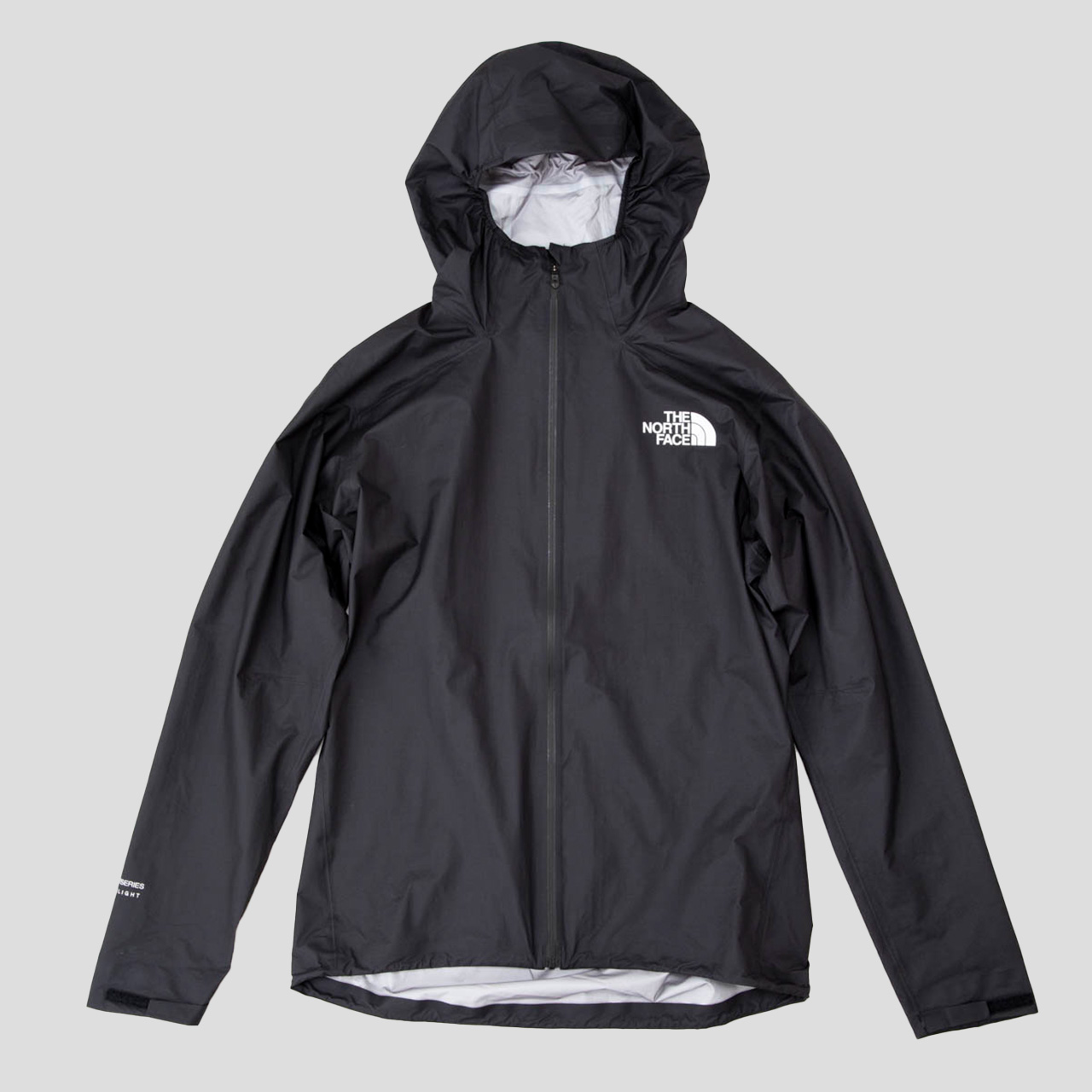
Weight: 125g
Material: FutureLight
Features: Nanofiber membrane
Construction: 3-layer
Surface fabric: 7 denier
Water pressure resistance: Not disclosed
Breathability : Not disclosed
⑧ yamatomichi UL All-weather Hoody
Highly Breathable and Simple No Zippers Design

Weight: 106g
Material: Pertex Shield Air
Features: Nanofiber membrane
Construction: 3-layer
Surface fabric: 7 denier
Water pressure resistance: 10000mm or more
Breathability: 10000g/㎡
Masaaki: Finally, we have The North Face’s “FL Trail Peak Jacket.” This product directly competes with Yamatomichi’s UL All-Weather series, so we’ll compare it with the UL All-Weather Hoody.
Takahiro: The Pertex Shield Air and North Face’s proprietary FutureLight used in these products have a mesh-like structure called a “nanofiber membrane,” allowing actual air to pass through, not just moisture, which is a significant feature. When FutureLight first appeared, it was seen as a slightly heavier, stretchy, soft material similar to Polartec NeoShell. However, the FL Trail Peak Jacket, with its 7-denier surface fabric, is quite crisp and non-stretchy, but it’s ultra-light at 125g.

Tomoyoshi: This product, in terms of material and concept, is similar to the UL All-Weather series. When a major brand follows your tracks, how does that make you feel Akira-san?
Akira: I haven’t used it in the field, so I can’t say for sure, but it doesn’t seem significantly different. So, I think users can choose based on their preference. For my part, the reason for creating the UL All-Weather series is that, like Rab’s Phantom Pull-On, it could be made even lighter. Still, by having high breathability, products like the UL All-Weather series and FL Trail Peak Jacket can double as wind shells, reducing the gear you need to carry. They can be used as wind shells when it’s not raining, so they’re more versatile than regular rainwear that stays in your pack most of the time. They’re comfortable to use, reducing the need to take them off and put them on frequently. Moreover, they pair well with highly breathable insulation, like active insulation. These innovations have made gear more interesting.
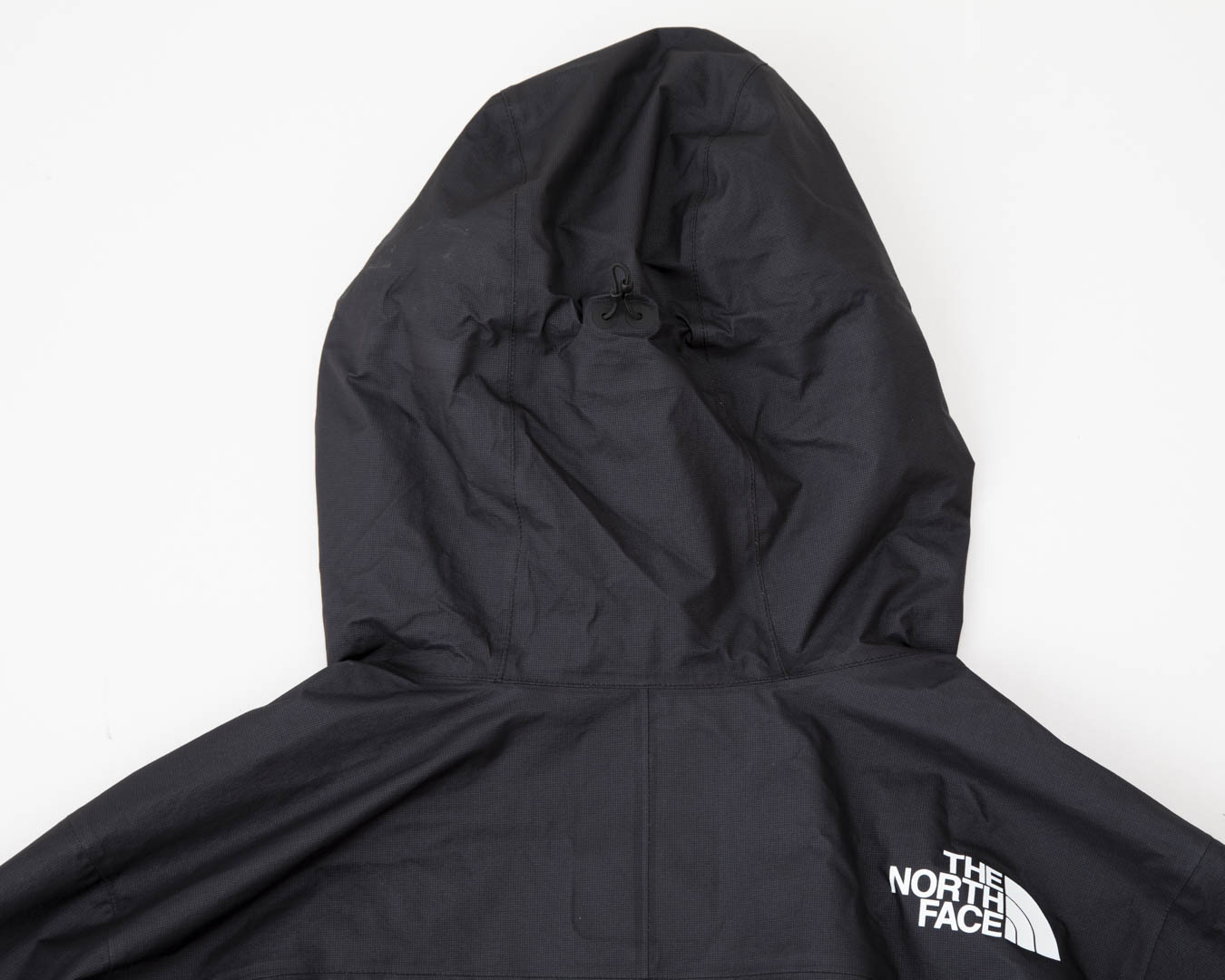
The FL Trail Peak Jacket’s hood has an adjuster at the back of the head.

The UL All-Weather Hoody’s hood has an adjuster under the chin.
Masaaki: How about the water pressure resistance of FutureLight?
Takahiro: FutureLight doesn’t disclose it. I’ve heard some items don’t meet 10,000mm.
Tomoyoshi: But probably, it’s not an issue.
Akira: UL All-Weather series also has lower waterproof and water pressure resistance compared to other types.
Masaaki: The specs for water pressure resistance should be adequate for rain, but compared to non-ventilated membranes, it tends to seep and feels colder, which I’ve experienced with the UL All-Weather series.
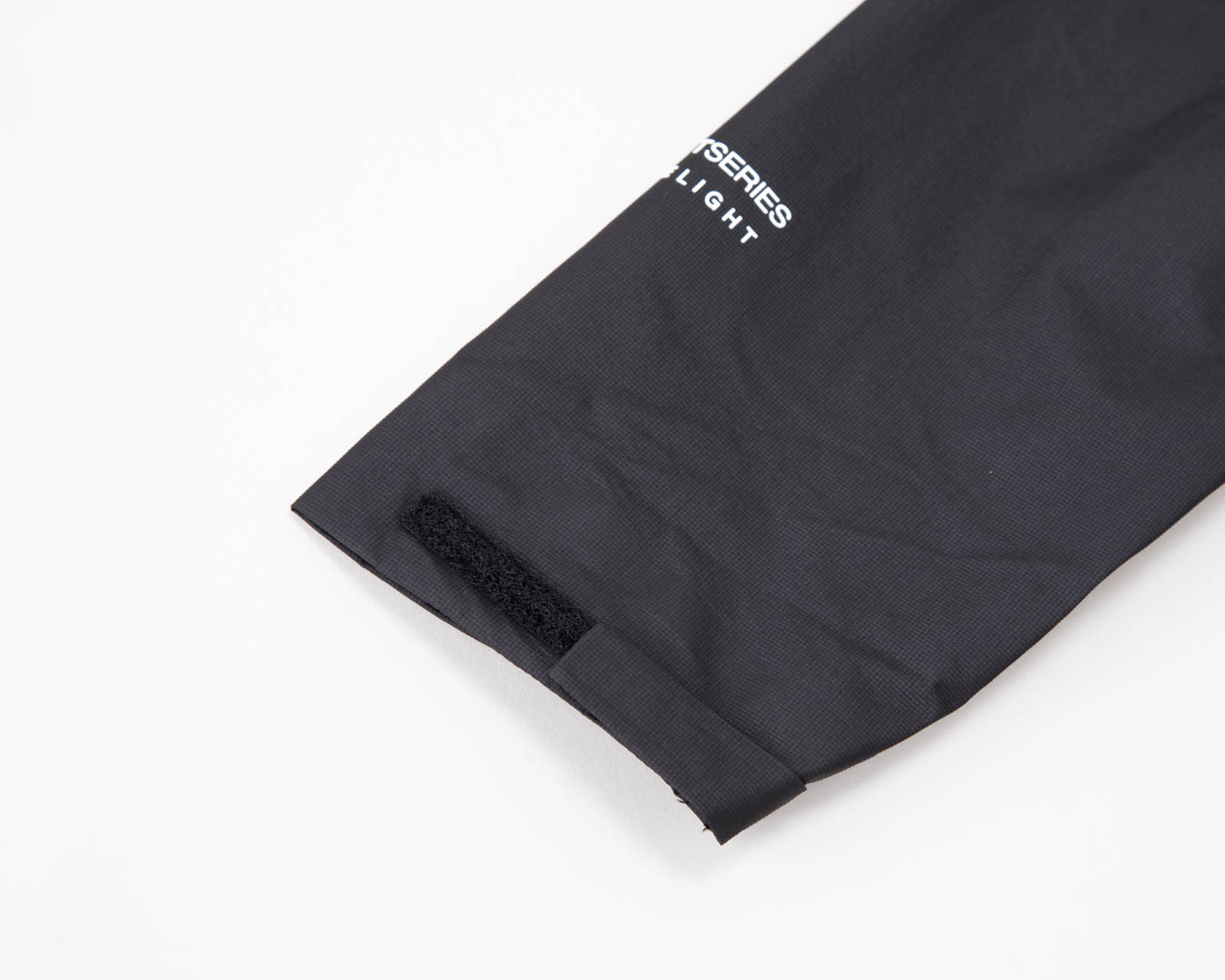
The FL Trail Peak Jacket’s cuffs have Velcro adjusters.
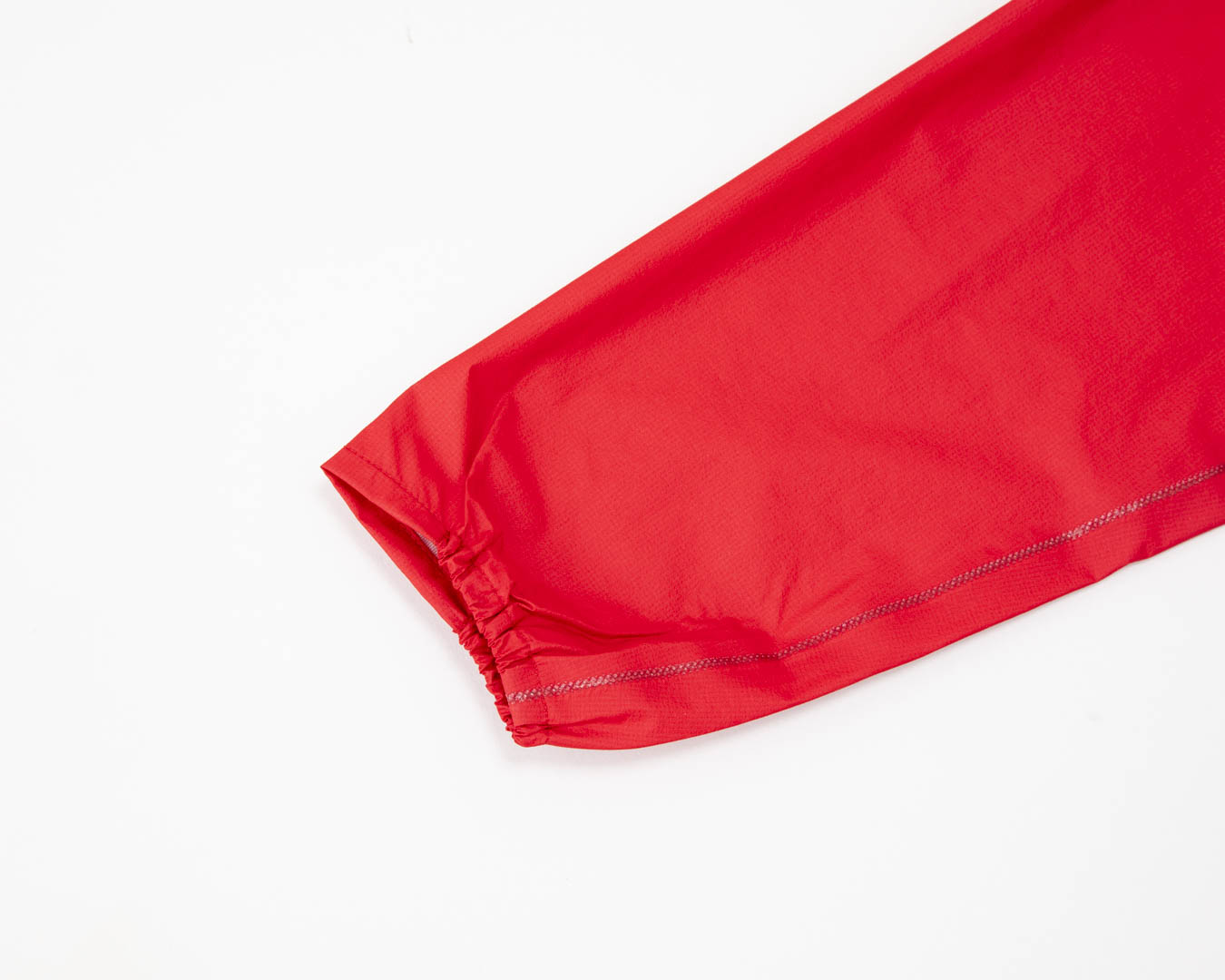
The UL All-Weather Hoody’s cuffs have no adjusters.
Tomoyoshi: This type of ventilated rainwear was made in mind that you’ll have layers underneath. About 25 years ago, when I was a student, the layering was simple: a synthetic T-shirt and a Gore-Tex raincoat, and that’s it. Very simple. But now, with these highly breathable Shells, layering has changed. These products, combined with highly breathable insulation like the Polartec Alpha, bring new layering options. its more than an evolution in rain wear; its an evolution in layering.
Akira: Although we’re talking about rainwear, the beauty is they have an use even when it’s not raining. What do you think?
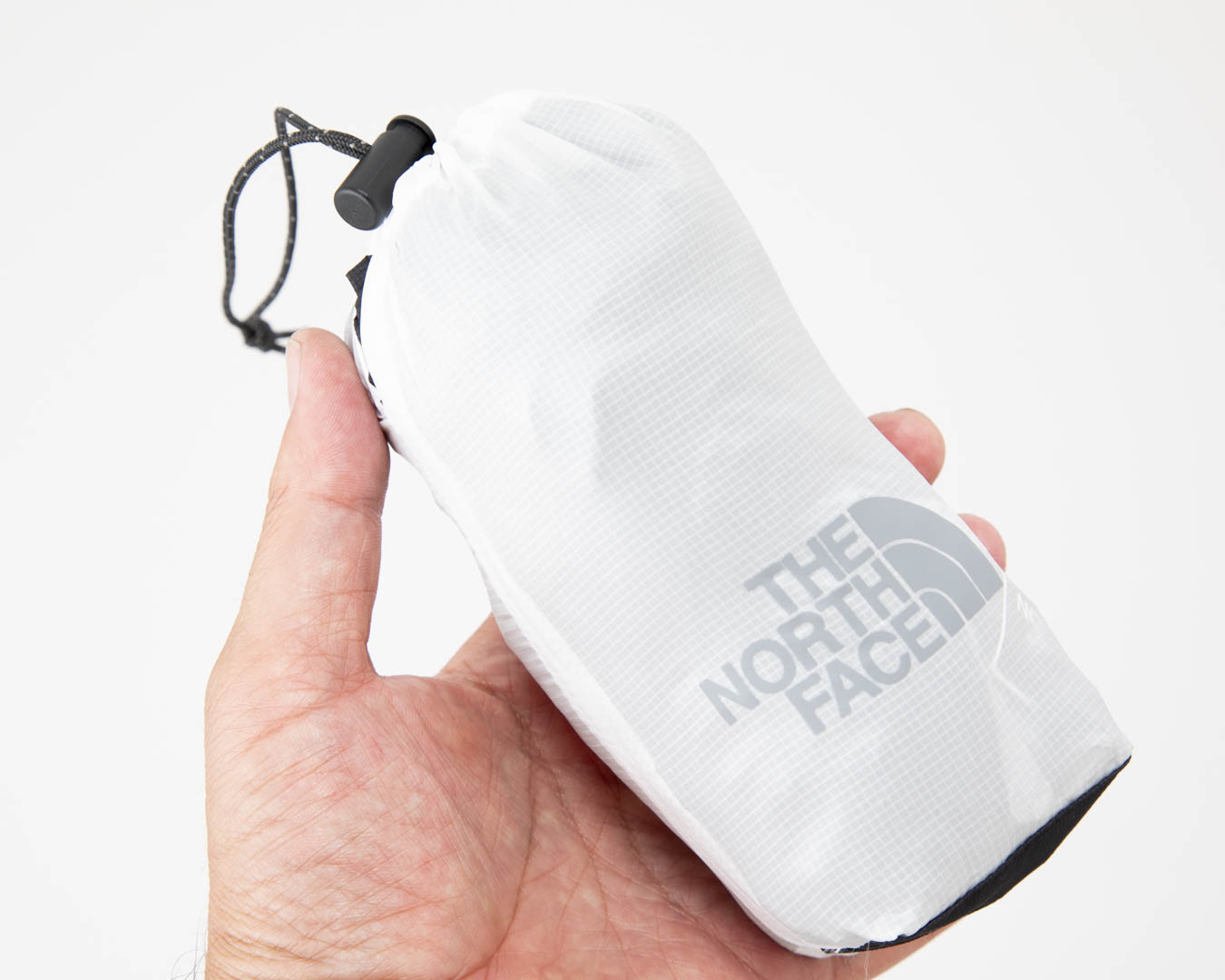
The FL Trail Peak Jacket comes with a stuff sack. When packed, it’s this compact.
Takahiro: Yes, the wind resistance is sufficient, and they remain comfortable in light rain. If you do get wet, you can continue comfortably with proper layering. These are more comfortable for continuous action compared to older models. I think ventilated types are very interesting for activities.
Masaaki: Tomoyoshi-san and I discussed in a previous Yamatomichi Lab article “Yamatomichi Lab [Rainwear Edition] #1 Special Talk Tomoyoshi Tomoyoshi x Akira Naatsume” (Only available in Japanese), the ultimate role of rainwear is not to prevent rain but to prevent hypothermia. It’s about maintaining enough insulation to keep warm even if you get wet.
Tomoyoshi: Right. But starting with hypothermia, people might think it means choosing insulated rainwear. But that misses the point. The primary function of rainwear is to keep you dry and windproof, so that you can maintain body temperature to prevent hypothermia.
Takahiro: Choosing materials that keep warm even when soaked is crucial.
Akira: High water resistance and waterproof items like Pertex Shield or Gore-Tex can get clammy and uncomfortable pretty quick. Nanofiber items are more comfortable with the extra breathability. But they don’t provide much warmth without layering.
Masaaki: People need to keep these things in mind to use this line of equiptment.
Akira: I think it’s more fun that you have to be cleaver in your layering.
Masaaki: Yamatomichi loves making these types of products that require critical thinking.
Tomoyoshi: In Yamatomichi Lab, we’ve talked layering to prevent feeling clammy or wet on “Yamatomichi Lab [Rainwear Edition] #8 Effects of Layering (Only available in Japanese)“. When choosing rainwear, some problems can be solved by what you wear underneath.

The UL All-wearther Hoody, instead of traditional sewing uses a new and advanced ultrasonic welding.
Masaaki: Since we’ve talked a lot about layering, I’d like to hear what specific layering everyone uses.
Akira: Basically, I always wear merino wool, not just in the rain. Merino wool generates heat when wet, ensuring more safety. I’m also interested in active insulation, and new synthetic materials that are emerging, so there are many options now, and more will come. What about you, Tomoyoshi-san?
Tomoyoshi: I also use merino wool, with mesh dry layers as my year-round base layer. I rarely wear synthetics, but I occasionally use active insulation. In this specialized context, I’d caution that OMM’s Core series or Yamatomichi’s Alpha series should be worn alone as base layers, as they don’t function well otherwise. Synthetics don’t absorb water, so they lose their quick-dry function if covered. They become insulation wear instead of base layers. For comfort, wear them alone and prioritize that. High activity makes them comfortable. Thus, I’ve returned to merino wool since I often layer and don’t have high activity levels.
Takahiro: I also wear merino wool. Yamatomichi recently released DF Mesh Merino, which remains comfortable even when wet. Synthetic base layers don’t dry under rainwear, so even if they are quick-drying, they stay wet. Therefore, wearing synthetic point-contact layers or those comfortable when wet is important.
Tomoyoshi: Synthetic quick-dry functions need air exposure. To maximize synthetic function, it’s crucial they’re exposed to air.
Masaaki: Previously, in Yamatomichi Lab, we independently tested whether wearing merino or polyester under rainwear affected perceived temperature and found a clear difference. Merino warms, but polyester cools, to an unexpected degree. Thus, we favor merino wool. We’ve done many unique tests, so please read past articles on Yamatomichi Lab!



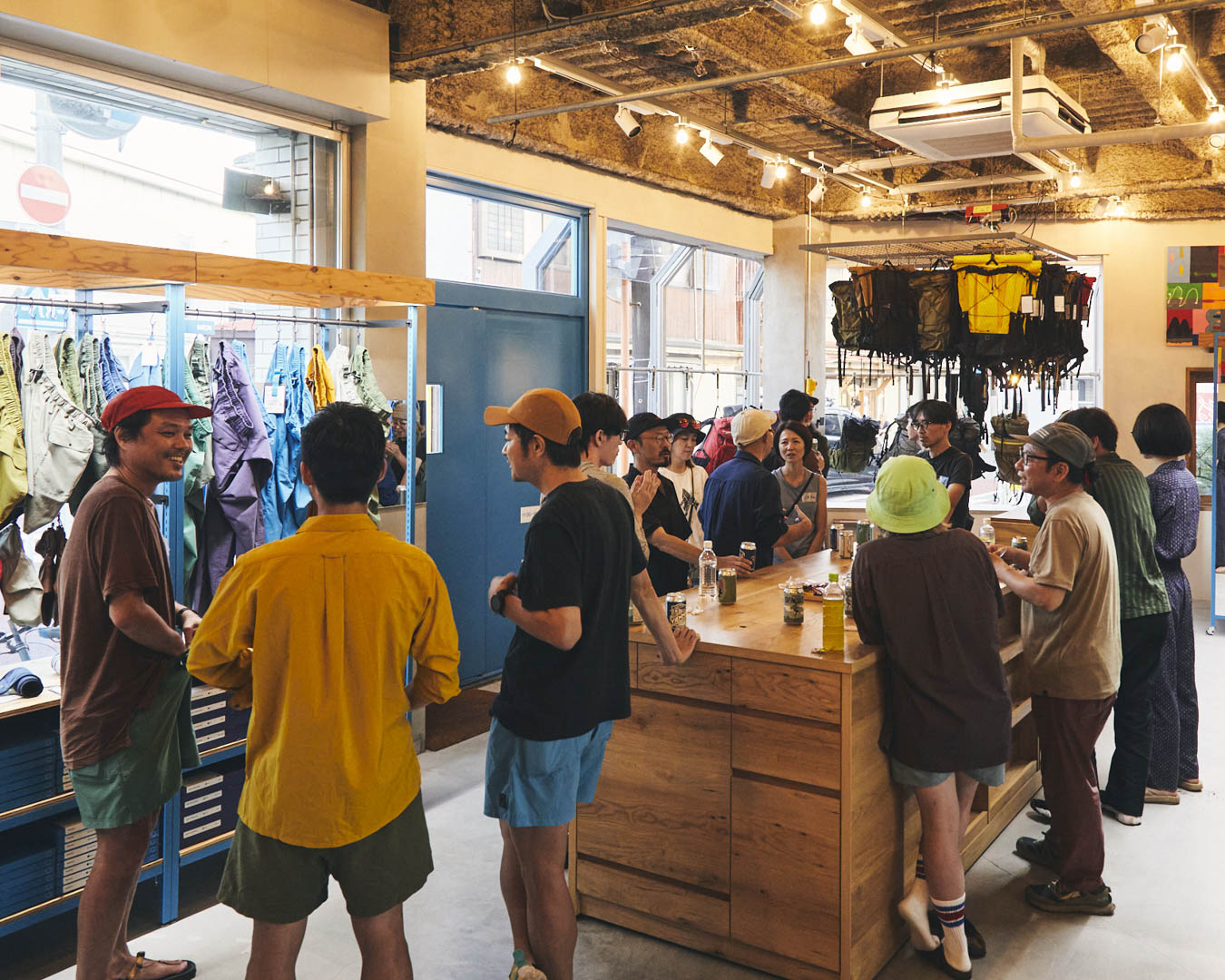
After the talk, we held a social gathering with participants.
Summary
Masaaki: Let’s wrap up. Tomoyoshi-san, how do you view current rainwear market trends?
Tomoyoshi: Since Yamatomichi’s UL All-Weather series launched, the trend has shifted to ventilated gear. The irreversible direction is to create rainwear that doesn’t get stuffy. This evolution has reached its peak with ventilated types, requiring consideration of insulation due to excellent ventilation.
Masaaki: Indeed. It’s beneficial to have highly ventilated rainwear.
Tomoyoshi: In the past, I experimented with using highly water-repellent wind jackets as rain gear. I’d spray a whole can of water repellent on a wind jacket, hoping it’d work,
but it failed. Now, it’s reality.
Masaaki: Montbell’s Versalite Jacket is similar, and Yamatomichi’s UL All-Weather series and The North Face’s FL Trail Peak Jacket can be worn as wind jackets due to their high ventilation.
Tomoyoshi: Besides lightness and ventilation, shape changes are noteworthy. Yamatomichi’s long versions (UL All-Weather Long Hoody and UL All-Weather Coat) don’t require rain pants with shorts, suggesting new usage ideas. I’m interested in exploring such ideas.
Akira: There are many options now, allowing users to choose based on their needs. Additionally, thicker rainwear balances water repellency and insulation but dries slowly when wet. Lightweight options, despite issues, dry quickly after shedding water, which is beneficial.
Masaaki: Quick drying is a key rainwear performance aspect. Do competitors stimulate you, Akira-san?
Akira: I think everyone has thoughtful designs. I propose my best, considering exciting or breakthrough approaches, so look forward to new products.
Masaaki: Trying different rainwear made me realize everyone’s unique approach despite similarities. It reflects various creators’ thoughts.
Tomoyoshi: This hour-long discussion highlights diverse rainwear differences, possibly confusing but emphasizing no perfect single choice. Specialized shops or direct stores can help organize fragmented information, matching products to individuals. Visit Yamatomichi shops in Kamakura or Kyoto, or find nearby stores to discuss and choose suitable gear.
Masaaki: We hope to continue detailed discussions on gear, so please join us again. Thank you, Tomoyoshi-san and everyone who gathered today!
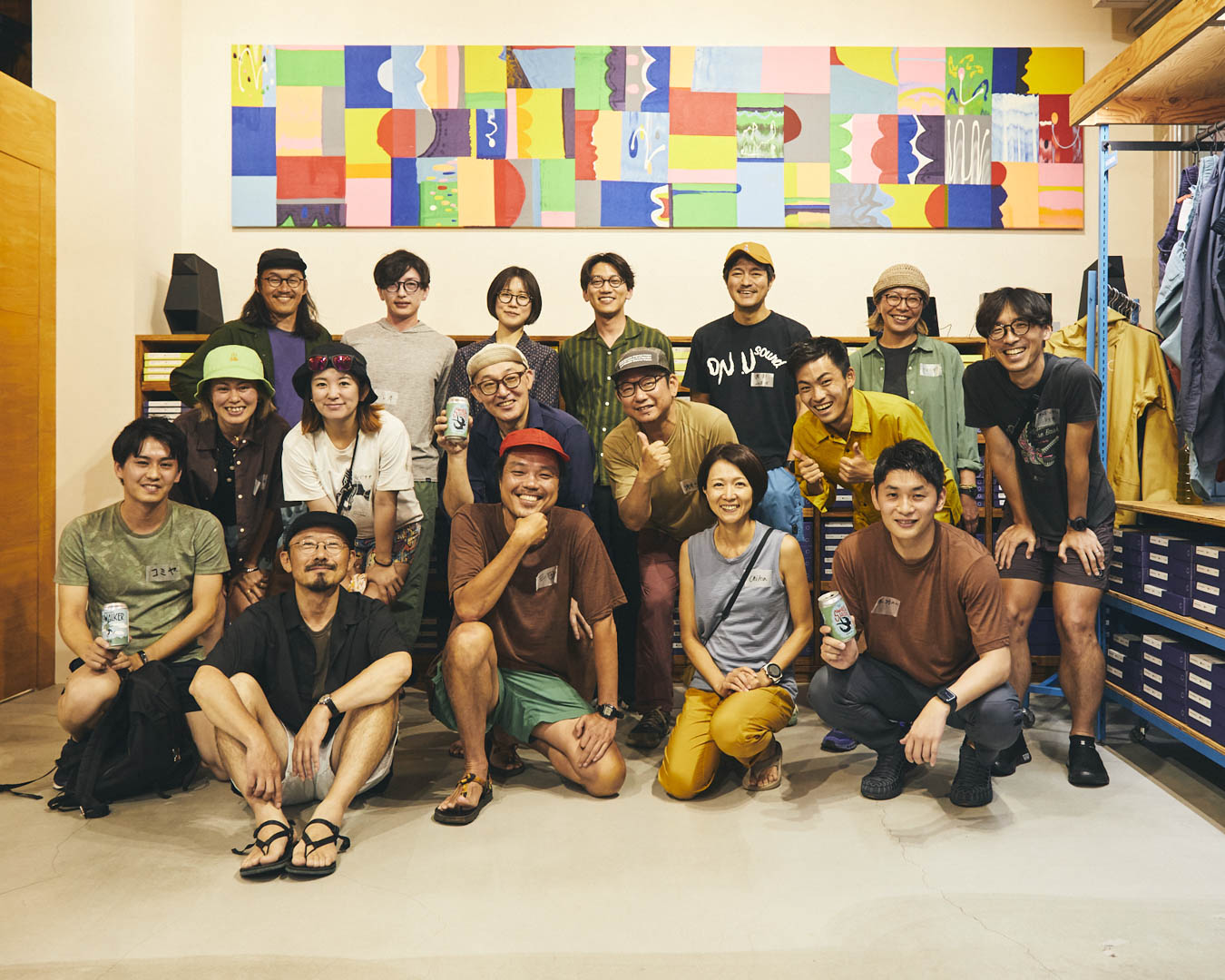
A commemorative photo with participants after the social gathering.








